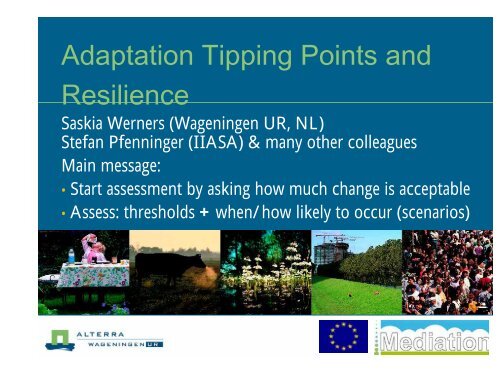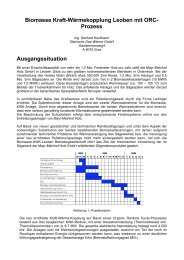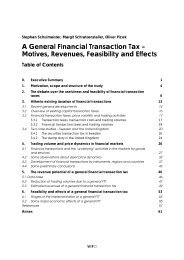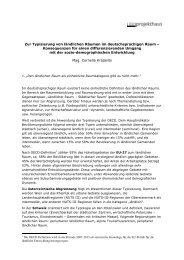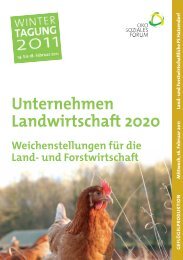Adaptation Tipping Points and Resilience
Adaptation Tipping Points and Resilience
Adaptation Tipping Points and Resilience
You also want an ePaper? Increase the reach of your titles
YUMPU automatically turns print PDFs into web optimized ePapers that Google loves.
<strong>Adaptation</strong> <strong>Tipping</strong> <strong>Points</strong> <strong>and</strong><br />
<strong>Resilience</strong><br />
Saskia Werners (Wageningen UR, NL)<br />
Stefan Pfenninger (IIASA) & many other colleagues<br />
Main message:<br />
• Start assessment by asking how much change is acceptable<br />
• Assess: thresholds + when/how likely to occur (scenarios)
Experiment
Experiment
Today<br />
Illustrate challenge for climate impact <strong>and</strong> vulnerability<br />
assessment<br />
Propose for assessment: ‘adaptation tipping points’<br />
Link to resilience discussion & future work<br />
Work in progress: ! your feedback much appreciated !<br />
Amsterdam<br />
Januari 2008
Illustrations – Delta Programme (Long term (2100) water safety,<br />
fresh water supply. Capitalise on opportunities water offers)<br />
Deltacommissioner Wim Kuijken (29 Sept.2010):<br />
One of the biggest challenges is dealing with uncertainties in the<br />
future climate, but also in population, economy <strong>and</strong> society. This<br />
One requires of the a new biggest way challenges of planning, is dealing which we with call uncertainties adaptive delta in the<br />
future planning. climate, It seeks but also to maximise in population, economy <strong>and</strong> society. This<br />
requires flexibility; a keeping new way options of planning, open which we call adaptive delta<br />
planning. <strong>and</strong> avoiding It seeks lock-in. to maximise flexibility; keeping options open<br />
In <strong>and</strong> the avoiding meantime, lock-in. we prepare In the the meantime, we prepare the so-called<br />
so-called delta decisions delta decisions about the about measures to take if our current water<br />
the system measures reaches to its take limits. if our current<br />
water system reaches its limits.<br />
Base values:<br />
• Solidarity<br />
• Flexibility<br />
• Sustainability
Source: Deltares
Assessment of ‘adaptation tipping points’<br />
Why:<br />
Climate change becomes relevant to policy makers if it threatens current policy<br />
objectives or results in conditions that society perceives as undesirable.<br />
If such a situation is thinkable, next to knowing the extent of the threat, at<br />
least equally important is to know when <strong>and</strong> how likely it is.<br />
The question is how much longer current policies <strong>and</strong> management are<br />
expected to suffice <strong>and</strong> when adjustments will be required. In other words,<br />
when are tipping points in the socio-political system reached?<br />
<strong>Adaptation</strong> tipping points:<br />
a situation where a socio-political threshold is reached, due to<br />
climate change induced changes in the bio-physical system.<br />
Socio-political thresholds:<br />
• formal policy objectives<br />
• informal societal preferences, willingness to invest/protect cultural identity
<strong>Tipping</strong> points <strong>and</strong> adaptation<br />
Korte<br />
Short term<br />
termijn<br />
measures ingrepen<br />
Major Grote Major “Grote<br />
Ingrepen interv. Ingrepen”<br />
intervention<br />
Available robustness <strong>and</strong> flexibility<br />
Beschikbare robuustheid en flexib. (RO)<br />
Benodigde robuustheid en flexib. (KV)<br />
Robustness<br />
Robuustheid<br />
Flexibility Flexibiliteit<br />
Mitigatie<br />
Required robustness <strong>and</strong> flexibility<br />
<strong>Tipping</strong> Omslagpunt Point<br />
<strong>Tipping</strong> Omslagpunt Point<br />
Time Tijd
Assessment of adaptation tipping points<br />
Ask: What are socio-political objectives (non-climate)?<br />
Select indicators <strong>and</strong> threshold values for impacts on sectors &<br />
regions: determine what situation is acceptable according to:<br />
• Analysis of policy objectives / st<strong>and</strong>ards / administrative<br />
arrangements<br />
• Public opinion, <strong>and</strong>/or<br />
• Statistics<br />
Danube Basin (ICPDR reports), e.g.:<br />
• Risk categories:<br />
Organic pollution, Hazardous substances, Nutrient pollution,<br />
Hydro-morphological alterations, Flood frequency<br />
• Loss of biodiversity / fish stock
Assessment of adaptation tipping points<br />
Determine adaptation tipping points: how much change sectors can h<strong>and</strong>le,<br />
given the thresholds value (independent from time) Ask: What climate<br />
conditions are critical for objectives? What are threshold conditions<br />
for reaching objectives (beyond which current strategy fails)<br />
Methods: compare with design criteria; consult experts / representatives from<br />
different sectors; assess historical variation of boundary conditions. System<br />
analysis linking climate conditions to the thresholds. Modelling effect of<br />
stepwise increasing climate conditions.<br />
Nature goals not reached<br />
Inlet fresh water too often too salt (Gouda)<br />
Design criteria storm surge barrier exceeded<br />
Storm surge barrier closed too frequent for port<br />
S<strong>and</strong> suppletion fails to meet coastal erosion<br />
Energy supply fails due to limits cooling capacity<br />
Tulip Norms fields for flood affected levees by not salinity met groundwater<br />
Note: Alternative presentation e.g.<br />
traffic light bar<br />
<strong>Tipping</strong> points for Rijnmond region (red dots). Green line: no tipping point (Jeuken et al., 2010).
Assessment of adaptation tipping points<br />
Translate tipping points to timescale: Use existing scenario (eg IPCC, or from<br />
national agencies) to assess when tipping points are likely to occur.<br />
Methods: use climate scenario’s, extreme/moderate (depends on sector);<br />
interpolate between projection year <strong>and</strong> now; express uncertainty earliest<br />
date/ latest date that climate change will have reached a certain value<br />
Nature goals not reached<br />
Inlet fresh water too often too salt (Gouda)<br />
Design criteria storm surge barrier exceeded<br />
Storm surge barrier closed too frequent for port<br />
S<strong>and</strong> suppletion fails to meet coastal erosion<br />
Energy supply fails due to limits cooling capacity<br />
Norms for flood levees not met
Assessment of adaptation tipping points<br />
Determine decision tree & adaptation pathways: Repeat 4 & 5 for these<br />
alternatives + assess how easy it is to switch in time (flexibility/‘no regret’)
Assessment of adaptation tipping points<br />
Determine alternative adaptation strategies: assess how to implement a<br />
different strategy or additional measures to postpone / resolve a tipping<br />
point (methods depend on scale, score these alternatives to policy targets)<br />
<strong>Adaptation</strong> pathways for the<br />
Theems estuary with<br />
increasing sea level<br />
The blue boxes are<br />
adaptation strategies<br />
(portfolios of option)<br />
The blue arrows show<br />
possibly transitions between<br />
strategies.<br />
In red the various scenarios<br />
(EnvironmentAgency, 2007)
Research objective<br />
The scientific objective is to gain a better underst<strong>and</strong>ing of the<br />
role of tipping points in adaptation to climate change <strong>and</strong> to<br />
elaborate the possibility <strong>and</strong> consequences of using adaptation<br />
tipping points for the identification of structural properties <strong>and</strong><br />
mechanisms that make socio-ecological systems robust <strong>and</strong>/or<br />
receptive to shocks to external shocks or internal perturbations<br />
The practical objective is to explore whether adaptation tipping<br />
points are a useful concept for assessing <strong>and</strong> communicating the<br />
implications of climate change, which can help decision makers<br />
in developing <strong>and</strong> prioritising adaptation strategies<br />
The adaptation tipping point perspective is chosen because it is<br />
appears a timely concept for bringing together concerns /<br />
insights about how much stress a system can absorb before<br />
losing its function <strong>and</strong> when this is likely to happen.
Central research questions<br />
Can adaptation tipping points be defined in such a way that they<br />
are an appropriate concept for assessing <strong>and</strong> communicating the<br />
implication of climate change & prioritise adaptation strategies?<br />
If so, how do these adaptation tipping points emerge? And<br />
(how) have the actions of agents contributed to adaptation<br />
tipping points?<br />
How to identify adaptation tipping points?<br />
What are possible responses to adaptation tipping points?<br />
What are consequences of working with adaptation tipping<br />
points for decision support?<br />
When do adaptation tipping points become decision tipping<br />
points, where management of socio-ecological systems shifts?
Conclusions / Experience<br />
Question: Can adaptation tipping points be defined in such a way that<br />
they are appropriate concept for assessing <strong>and</strong> communicating the<br />
implication of climate change & prioritise adaptation strategies?<br />
• Closer to the question of policy maker/manager/ stakeholder<br />
•<br />
•<br />
•<br />
Allows for dialogue between scientific & policy community.<br />
Expressing uncertainty in time (when will a critical point be<br />
reached) is easier to underst<strong>and</strong> than % change in a certain<br />
projection year<br />
Some times far from trivial<br />
(not the silver bullet) because……
Our water<br />
system is<br />
very<br />
resilient!”
Thanks! & Discussion<br />
Contact: werners@mungo.nl saskia.werners@mungo.nl
Discussion: what you like / dislike about adaptation tipping points<br />
suggestions comments:<br />
- few governments have foresight to be concerned<br />
- real concern about long run problems<br />
- how to measure tipping points & deal with long horizon<br />
- nature of tipping point / threshold not very precise: scale <strong>and</strong><br />
- definition: conceptual background?<br />
- change / transformation in policy<br />
- physical / policy proces analysed? what tipping points<br />
- plurality different types of coupled systems. typing points are dynamic in time<br />
- developng country context? tipping points already reached?<br />
- note: tolerable risk community
Extras
<strong>Adaptation</strong> tipping points<br />
Assess:<br />
• What are socio-political objectives [e.g. in policy docs]?<br />
• Are objectives currently met?<br />
• Are What climate conditions are critical for objectives?<br />
• What are threshold conditions for reaching objectives (tipping<br />
points)<br />
• When are thresholds reached according to various climate<br />
scenarios?<br />
• What are adaptive responses / alternative measures<br />
(Kwadijk, 2010)
Assessment of adaptation tipping points<br />
1. Scoping the assessment: make a long list of possible consequences of<br />
climate change for a region or sectors<br />
2. Prioritise climate change trends <strong>and</strong> impacts: From long list to short list.<br />
Select impacts based on potential severity <strong>and</strong> likeliness (e.g. build urgency<br />
matrix (use trends + extreme scenarios))<br />
3. Select indicators <strong>and</strong> threshold values: determine what effects are<br />
acceptable according to: Analysis of policy objectives / st<strong>and</strong>ards /<br />
administrative arrangements, Public opinion, <strong>and</strong>/or Statistics<br />
4. Determine adaptation tipping points: how much change sectors can<br />
h<strong>and</strong>le, given the thresholds value (independent from time) (e.g. by system<br />
analysis linking climate conditions to the thresholds)<br />
5. Translate tipping points to timescale: Use existing scenario (eg IPCC, or<br />
from national agencies) to assess when tipping points are likely to occur<br />
6. Determine alternative adaptation strategies: assess how to implement a<br />
different strategy or additional measures to postpone / resolve a tipping<br />
point (methods depend on scale, score these alternatives to policy targets)<br />
7. Determine decision tree & adaptation pathways: Repeat 4 & 5 for these<br />
alternatives + assess how easy it is to switch in time (flexibility/‘no regret’)
Assessment of vuln. / adaptation tipping points<br />
1. Scoping the assessment: make a long list of possible consequences of<br />
climate change for a region or sectors<br />
Rows: Effects of climate change + scores of likelihood<br />
Columns: Impacts (on flood safety, fresh water supply, economic activities<br />
(navigation, drinking water, power production)+ scores of severity)
Assessment of adaptation tipping points<br />
2. Prioritise climate change trends <strong>and</strong> impacts: From long list to short list.<br />
Select impacts, sectors & regions based on potential severity <strong>and</strong> likeliness<br />
(e.g. build urgency matrix (use trends + extreme scenarios))<br />
When carried out with stakeholders provides commitment<br />
to those issues that need to be addressed
Assessment of adaptation tipping points<br />
6. Determine alternative adaptation strategies: assess how to implement a<br />
different strategy or additional measures to postpone / resolve a tipping<br />
point (methods depend on scale, score these alternatives to policy targets)
Many different approaches
Impact assessment / indicators / IPCC
Climate<strong>Adaptation</strong> Atlas: Maps, Traffic light
Storylines & development pathways (PBL)<br />
Semi-urban<br />
Multifunctional semi-urban agriculture Intensive agriculture<br />
Diversify Specialize /<br />
Multifunctional rural agriculture<br />
Large scale agriculture<br />
world market<br />
Rural
Integrale adaptatiestrategieën<br />
Urban<br />
Little competition /<br />
regional market<br />
Strong<br />
competition /<br />
world market<br />
Rural
<strong>Adaptation</strong> – addressing different drivers
Assessment questions<br />
What do we<br />
adapt to?<br />
How do we<br />
adapt?<br />
Enabling<br />
factors?<br />
Effectiveness<br />
of option?<br />
Climate<br />
adaptation<br />
What do we<br />
want to achieve?<br />
Who adapts?<br />
Whose goal?<br />
After: Preston (2010)
A combination…?
The vulnerability assessment approach<br />
Review of the suitability of existing typologies for<br />
ecosystems, based on:<br />
-EU Habitat <strong>and</strong> Birds Directives <strong>and</strong> Natura 2000 data base<br />
-Carpathian Biodiversity Information System<br />
-L<strong>and</strong> cover data for the Carpathian region<br />
-European <strong>and</strong> National Forest Inventories<br />
-Pan European Ecological Network (PEEN)<br />
-European Topic Center on Biological Diversity<br />
Selection of the suitable typology for ecosystems for input<br />
into the vulnerability assessment matrix<br />
Vulnerability assessment of the climate change threats for<br />
each ecosystem according to the selected typology


